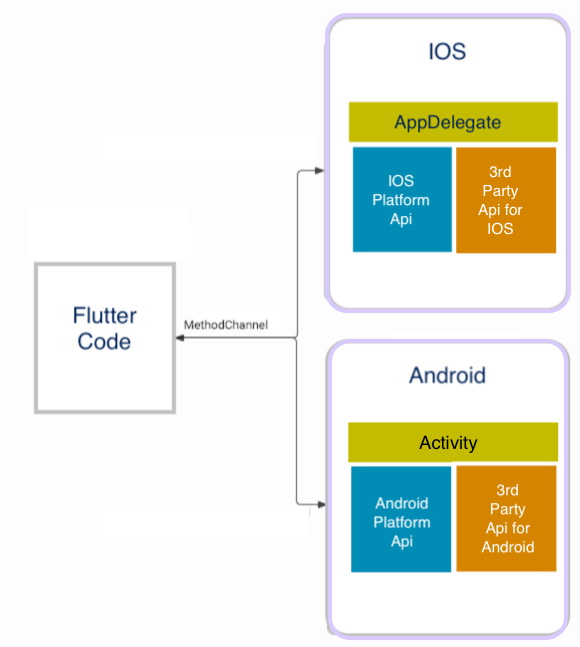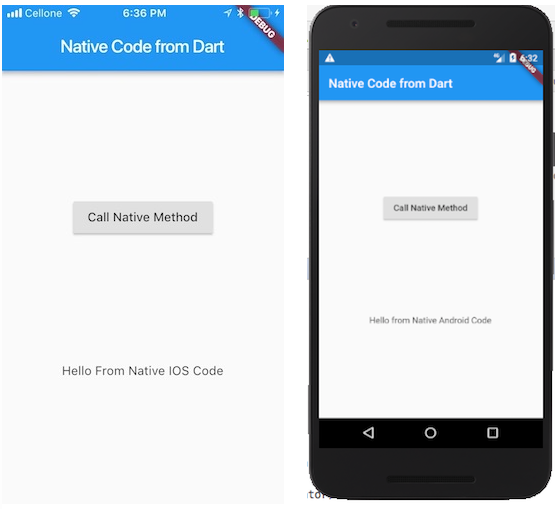Latest news about Bitcoin and all cryptocurrencies. Your daily crypto news habit.
How to develop a Bridge in Flutter between Dart and Native Code
Flutter allows us to call platform-specific APIs available in Java or Kotlin code on Android and in Objective C or Swift code on iOS.
Flutter’s platform-specific API works with message passing.
From Flutter app we have to send messages to a host on iOS or Android parts of the app over a platform channel. The host listens on the platform channel and receives the message. It then uses any platform-specific APIs using the native programming language and sends back a response to the Flutter portion of app.
Architecture overview
Messages are passed between the Flutter Code(UI) and host (platform) using platform channels. Messages and responses are passed asynchronously and the user interface remains responsive.
On Dart side using MethodChannel(API) we send a message which is corresponding to a method call. On the Android side MethodChannel Android (API) and on the iOS side FlutterMessageChannel (API) is used for receiving method calls and sending back result. These classes allow us to develop a platform plugin with a very simple code.
If required, method calls can also be sent in the reverse direction, with the Android/IOS platform acting as client and method implemented in Dart.
Data types supported by Platform Channel
The standard platform channel uses standard message codec that supports efficient binary serialization of simple JSON-like values of types boolean, number, String, byte buffer, list, and map. The serialization and deserialization of these values to and from messages happen automatically when we send and receive values.
Creating flutter app that calls iOS and Android code
Now we will create a flutter app with a method call that will be implemented in Android (Java) and iOS (Objective C) respectively.
1. Create a new app project
In a terminal run:
flutter create flutter_to_native
By default, Flutter supports writing Android code in Java and iOS code in Objective C. If you want to use Kotlin and Swift, create a project with the following command.
flutter create -i swift -a kotlin flutter_to_native
2. Create a platform Channel
The client and host sides of the channel are connected through the channel name passed in the channel constructor. All channel names used in a single app must be unique. In our example, we are creating the channel name flutter.native/helper
class _MyHomePageState extends State<MyHomePage> {static const platform = const MethodChannel('flutter.native/helper');3. Invoke method on platform Channel
Invoke a method on the method channel, specifying the concrete method to call via the String identifier. In the code below, it is helloFromNativeCode
String response = "";try {final String result = await platform.invokeMethod('helloFromNativeCode'); response = result; } on PlatformException catch (e) { response = "Failed to Invoke: '${e.message}'."; }Use the returned response to update the user interface state inside setState.
setState(() {_responseFromNativeCode = response;});4. Create method implementation in Android using java
In Android Studio open Flutter app and select the android folder inside it. Open the file MainActivity.java
Now we have to create a MethodChannel with the same name that we have created in Flutter App.
public class MainActivity extends FlutterActivity {private static final String CHANNEL = "flutter.native/helper";We have to create a MethodCallHandler in onCreate method
new MethodChannel(getFlutterView(), CHANNEL).setMethodCallHandler(new MethodChannel.MethodCallHandler() { @Overridepublic void onMethodCall(MethodCall call, MethodChannel.Result result) {if (call.method.equals("helloFromNativeCode")) { String greetings = helloFromNativeCode(); result.success(greetings); } }});5. Create method implementation in iOS using Objective C
Open the file AppDelegate.m of your Flutter app in Xcode. Now we have to create a FlutterMethodChannel with the same name that we have created in Flutter App.
FlutterViewController* controller = (FlutterViewController*)self.window.rootViewController; FlutterMethodChannel* nativeChannel = [FlutterMethodChannel methodChannelWithName:@"flutter.native/helper"binaryMessenger:controller];
Create method call handler
[nativeChannel setMethodCallHandler:^(FlutterMethodCall* call, FlutterResult result) {if ([@"helloFromNativeCode" isEqualToString:call.method]) { NSString *strNative = [weakSelf helloFromNativeCode]; result(strNative); } else { result(FlutterMethodNotImplemented); }}];Complete Code
Android Native code
import android.os.Bundle;import io.flutter.app.FlutterActivity;import io.flutter.plugin.common.MethodCall;import io.flutter.plugin.common.MethodChannel;import io.flutter.plugins.GeneratedPluginRegistrant;
public class MainActivity extends FlutterActivity {private static final String CHANNEL = "flutter.native/helper"; @Overrideprotected void onCreate(Bundle savedInstanceState) {super.onCreate(savedInstanceState); GeneratedPluginRegistrant.registerWith(this);new MethodChannel(getFlutterView(), CHANNEL).setMethodCallHandler(new MethodChannel.MethodCallHandler() { @Overridepublic void onMethodCall(MethodCall call, MethodChannel.Result result) {if (call.method.equals("helloFromNativeCode")) { String greetings = helloFromNativeCode(); result.success(greetings); } }}); }private String helloFromNativeCode() {return "Hello from Native Android Code"; }}iOS native code
#include "AppDelegate.h"#include "GeneratedPluginRegistrant.h"@implementation AppDelegate - (BOOL)application:(UIApplication *)application didFinishLaunchingWithOptions:(NSDictionary *)launchOptions { FlutterViewController* controller = (FlutterViewController*)self.window.rootViewController; FlutterMethodChannel* nativeChannel = [FlutterMethodChannel methodChannelWithName:@"flutter.native/helper"binaryMessenger:controller]; __weak typeof(self) weakSelf = self; [nativeChannel setMethodCallHandler:^(FlutterMethodCall* call, FlutterResult result) {if ([@"helloFromNativeCode" isEqualToString:call.method]) { NSString *strNative = [weakSelf helloFromNativeCode]; result(strNative); } else { result(FlutterMethodNotImplemented); } }]; [GeneratedPluginRegistrant registerWithRegistry:self];return [super application:application didFinishLaunchingWithOptions:launchOptions]; } - (NSString *)helloFromNativeCode {return @"Hello From Native IOS Code"; }@endFlutter code
import 'package:flutter/material.dart';import 'dart:async';import 'package:flutter/services.dart';void main() => runApp(new MyApp());class MyApp extends StatelessWidget { @override Widget build(BuildContext context) {return new MaterialApp( home: new HomePage(), ); }}class HomePage extends StatelessWidget { @override Widget build(BuildContext context) {return new Scaffold( appBar: new AppBar( title: const Text('Native Code from Dart'), ), body: new MyHomePage(), ); }}class MyHomePage extends StatefulWidget { MyHomePage({Key key, this.title}) : super(key: key);final String title; @override _MyHomePageState createState() => new _MyHomePageState();}class _MyHomePageState extends State<MyHomePage> {static const platform = const MethodChannel('flutter.native/helper'); String _responseFromNativeCode = 'Waiting for Response...'; Future<void> responseFromNativeCode() async { String response = "";try {final String result = await platform.invokeMethod('helloFromNativeCode'); response = result; } on PlatformException catch (e) { response = "Failed to Invoke: '${e.message}'."; } setState(() {_responseFromNativeCode = response; }); } @override Widget build(BuildContext context) {return Material( child: Center( child: Column( mainAxisAlignment: MainAxisAlignment.spaceEvenly, children: [ RaisedButton( child: Text('Call Native Method'), onPressed: responseFromNativeCode, ), Text(_responseFromNativeCode), ], ), ), ); }}Result
Run the code on Android and iOS devices. Click on the Button “Call Native Method”
Thanks to Atul Sharma for the article. If you enjoyed this article, feel free to hit that clap button 👏 to help others find it.
This article is a part of the series of articles related to mobile technology. If you are looking for a mobile app development team, please contact us at info@47billion.com.
Originally published at 47billion.com on January 15, 2019.
Creating a Bridge in Flutter between Dart and Native Code was originally published in Hacker Noon on Medium, where people are continuing the conversation by highlighting and responding to this story.
Disclaimer
The views and opinions expressed in this article are solely those of the authors and do not reflect the views of Bitcoin Insider. Every investment and trading move involves risk - this is especially true for cryptocurrencies given their volatility. We strongly advise our readers to conduct their own research when making a decision.


